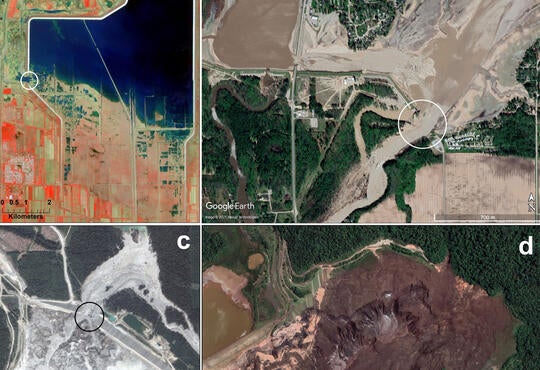Contact
![]()
 Maria Strack, Department of Geography and Environmental Management
Maria Strack, Department of Geography and Environmental Management
Introduction
Nature-based climate solutions (NbS) have the potential to play an important role in greenhouse gas (GHG) emission reductions and carbon dioxide (CO2) removal, particularly in the next decade. Their importance was discussed at the Conference of the Parties to the United Nations Framework Convention of Climate Change (UNFCCC) in the UK in 2021, also referred to as COP26. NbS involve land management actions that reduce GHG emissions or result in GHG uptake. NbS generally arise from avoiding conversion of underdeveloped natural or intact areas, reducing the impact of disturbance on ecosystem GHG emissions through better management, and ecological restoration. This article focuses on one specific ecosystem, namely peatlands.
Peatlands are wetland ecosystems with thick layers of partially decomposed plants stored in their soils. Although peatlands cover only 3 per cent of the planet’s land surface, they are the largest terrestrial organic carbon stock in the world with at least 600 Gt of stored carbon. This is equivalent to about 30 per cent of all soil carbon. Undisturbed peatlands are hence large carbon sinks. However, there are fears that anthropogenic and environmental factors could be altering the balance, turning peatlands into carbon sources. Degraded peatlands account for 5 per cent of current anthropogenic greenhouse gas (GHG) emissions and therefore reducing emissions through rewetting and restoration offer substantial emission reductions.
In this paper, the authors review different peatland management pathways that can contribute to NbS and compiles regional and global estimates for the size of the potential GHG emission reductions.
Pathways for peatlands as nature-based solutions
The various pathways discussed below for peatlands as a NbS and the associated exchange of GHG emissions are shown in Figure 1. Red arrows indicate that an action results in an increase in GHG emissions and green arrows a decrease in emissions.
Figure 1: Shifts in peatlands use and management and effects on greenhouse gas exchange.
Avoid disturbance by conserving peatlands
Although peatland disturbance occurs across the globe, at least 75 per cent of peatlands remain in a relatively undisturbed state. Climate change will alter the rate of peatland carbon cycling, but northern peatlands, accounting for over 85 per cent of the global peatland area and approximately 80 per cent of the peat carbon stock, are expected to continue to act as carbon sinks or only very small sources until 2100. Therefore, conserving these undisturbed peatlands is critical to avoid additional GHG emissions.
Considering conservation of peatlands as a NbS is mainly relevant in areas that are at risk of being disturbed, for example as a result of land use change. In Canada, it has been estimated, for example, that up to 10 Mt of carbon dioxide equivalent (CO2e) per year of GHG emissions can be saved by avoiding peatland conversion by 2030. In temperate regions of North America and Europe many peatlands have been drained for human use, in particular agriculture, and intact peatlands are less common. Nonetheless calls for protection of remaining peat carbon stocks are widespread. In the Tropics, peatlands are mainly found in Indonesia and Malaysia, the upper Amazon (Peru and Brazil) and the Congo basin, covering an area of 90-170 million ha with a total carbon stock of 152-288. Vast peatlands were recently found in Amazonia and the central Congo basin.
It is expected that peatland carbon emissions due to land use change until 2100 will be 14 Gt C for temperate, boreal and subarctic regions and 13 Gt C in the tropics. Avoiding this new peatland conversion could amount to an annual emission reduction of 305-754 Mt CO2e in 2030.
Mitigate GHG emissions as a result of peatland disturbance
Complete avoidance of disturbance may not be possible in areas where livelihoods depend on peatland utilization. In this case, an alternative to reduce GHG would be to change management practices. The most widely applied and studied management practice is paludiculture, the production of crops on wet soils. Here, the cultivation of alternative crops takes place on peatland under a range of hydrological conditions, ranging from rewetted systems, where the stored peat carbon is protected by high water tables, to systems that retain some extent of drainage and may continue to act as sources of carbon to the atmosphere.
Field trials have observed clear GHG emission reductions in paludiculture. Greater emission reductions can be achieved when the water table is kept closer to the surface, but any reduction in drainage depth likely results in some level of emission reductions. However, in all these cases there will be some degree of economic loss compared to conventional farming practices and hence the economic viability of paludiculture is therefore an important barrier to its adoption.
Other management practices have also been identified. These include, for example, the adoption of best management practices during peat extraction, geologic exploration, forestry, and energy development projects. In addition, fuel management treatments have been tested in boreal peatlands to reduce wildfire severity and experiments are ongoing related to, for example, the management of animal populations like the introduction of grazing large herbivores to reduce snowpack insulation and retain permafrost or beavers to maintain high water levels and rewet previously drained peatlands through dam building. However, the effects of these other management practices are unclear since data is lacking or is collected from only a few case studies.
Restoration of peatlands
Actions to promote peatland recovery have been applied in many regions in the world, in which the main goal is to re-wet these landscapes to bring back suitable hydrological conditions needed to support carbon sequestration and avoid further carbon losses. Effective restoration of disturbed peatlands needs four R’s: rewetting, revegetation, revitalization of livelihood and reducing fires, of which rewetting and accompanying reduction of fire risk and severity have the highest priority. Under drained conditions, peat carbon stocks are highly vulnerable to combustion during wildfire, with potential for globally significant emissions. For example, peat fires in Indonesia in 1997 released 0.8 to 2.6 Gt C, an amount equivalent to 13-40 per cent of all global annual carbon emissions in that year. Therefore, rewetting drained peatlands has the added benefit of reduced GHG emissions from peatland wildfire.
At ecosystem scale, GHG emission reductions associated with rewetting and restoration have been demonstrated in a range of temperate and boreal peatland types and following a variety of disturbances. In tropical peatland the soil water regime is one of the most important factors for controlling the carbon balance. Peat decomposition is negatively correlated to the ground water level (GWL). At ecosystem scale, every 10 cm rise of the minimum monthly-mean GWL, which is usually measured in the late dry season, has been shown to reduce net CO2 emission by 1.8 t CO2 ha-1 yr-1 in peat swamp forests. At the global scale, restoration of all currently degraded peatlands could result in GHG emission reductions of 801-1900 Mt CO2e, with over half of the emission reductions arising from peatland restoration in the Tropics.
Conclusions
Peatland ecosystems play a key role in slowing anthropogenic climate change since they represent the largest terrestrial organic carbon stock. However, increasing demand for food production, horticultural peat, and resource extraction continues to put pressure on peatlands. There are important trade-offs between peatland conservation and development that need to be adequately informed based on a more comprehensive overview of the various co-benefits provided by peatland ecosystems. This includes flood control, maintenance of water quality, reduced land subsidence, fire risk management, human health and well-being, and biodiversity. Climate change needs to be accounted for too since this poses additional challenges through the change in water resource availability and the increasing frequency of extreme events regardless of the level of peatland protection from future development.
The growing interest in NbS calls for actions to address climate change and sustainable development simultaneously. NbS application can only be successful if it does not delay the decarbonization of economies, incorporates a wide range of ecosystems, engages local communities and Indigenous people, supports, sustains, or enhances biodiversity, and provides long-term protections to ecosystems. To achieve the emission reductions reported in this overview, undeveloped peatlands need policies for their protection from local to international levels, where effective implementation requires collaboration across levels of government, with the involvement of local communities and Indigenous peoples.
Strack, M., Davidson, S. J., Hirano, T., & Dunn, C. (2022). The Potential of Peatlands as Nature-Based Climate Solutions. Current Climate Change Reports, 8(3), 71–82. https://doi.org/10.1007/s40641-022-00183-9
For more information about WaterResearch, contact Julie Grant.
Photo Credit: Maria Strack






